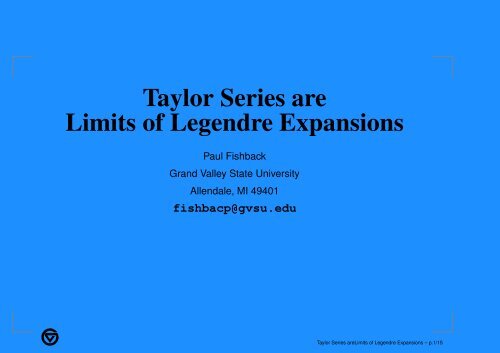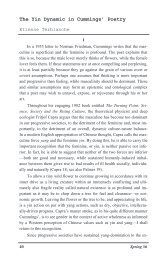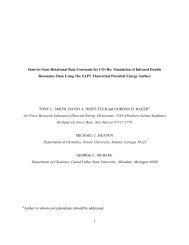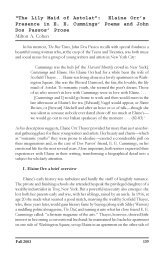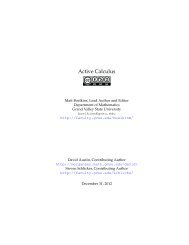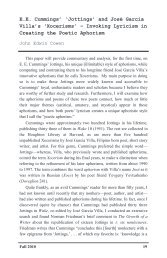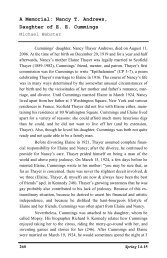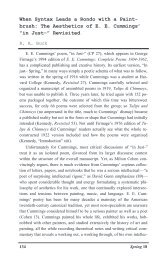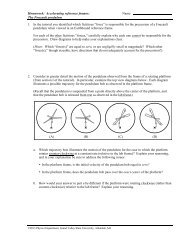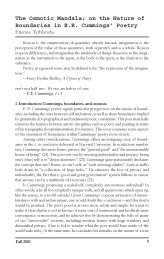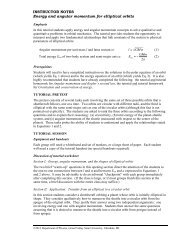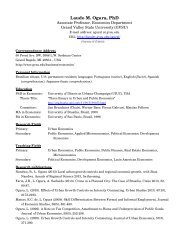Taylor Series are Limits of Legendre Expansions - Gvsu - Grand ...
Taylor Series are Limits of Legendre Expansions - Gvsu - Grand ...
Taylor Series are Limits of Legendre Expansions - Gvsu - Grand ...
Create successful ePaper yourself
Turn your PDF publications into a flip-book with our unique Google optimized e-Paper software.
<strong>Taylor</strong> <strong>Series</strong> <strong>are</strong><br />
<strong>Limits</strong> <strong>of</strong> <strong>Legendre</strong> <strong>Expansions</strong><br />
Paul Fishback<br />
<strong>Grand</strong> Valley State University<br />
Allendale, MI 49401<br />
fishbacp@gvsu.edu<br />
<strong>Taylor</strong> <strong>Series</strong> <strong>are</strong><strong>Limits</strong> <strong>of</strong> <strong>Legendre</strong> <strong>Expansions</strong> – p.1/15
A Common Question in Calculus<br />
Can we determine the interval <strong>of</strong> convergence <strong>of</strong> a <strong>Taylor</strong><br />
series corresponding to a function f simply by looking at f<br />
itself?<br />
<strong>Taylor</strong> <strong>Series</strong> <strong>are</strong><strong>Limits</strong> <strong>of</strong> <strong>Legendre</strong> <strong>Expansions</strong> – p.2/15
A Common Question in Calculus<br />
Can we determine the interval <strong>of</strong> convergence <strong>of</strong> a <strong>Taylor</strong><br />
series corresponding to a function f simply by looking at f<br />
itself?<br />
0.8<br />
0.7<br />
0.6<br />
f(x) = 1<br />
x 2 + 4<br />
y<br />
0.5<br />
0.4<br />
0.3<br />
0.2<br />
0.1<br />
–2 –1 0<br />
1 2<br />
x<br />
<strong>Taylor</strong> <strong>Series</strong> <strong>are</strong><strong>Limits</strong> <strong>of</strong> <strong>Legendre</strong> <strong>Expansions</strong> – p.2/15
<strong>Taylor</strong>’s Theorem<br />
If f is analytic in the open disk <strong>of</strong> radius R > 0 , then we<br />
may write for z in this disk,<br />
f(z) =<br />
∞∑<br />
n=0<br />
a n z n ,<br />
<strong>Taylor</strong> <strong>Series</strong> <strong>are</strong><strong>Limits</strong> <strong>of</strong> <strong>Legendre</strong> <strong>Expansions</strong> – p.3/15
<strong>Taylor</strong>’s Theorem<br />
If f is analytic in the open disk <strong>of</strong> radius R > 0 , then we<br />
may write for z in this disk,<br />
f(z) =<br />
∞∑<br />
n=0<br />
a n z n ,<br />
2<br />
where<br />
y<br />
–2 –1 0 1 2<br />
x<br />
–1<br />
–2<br />
1<br />
a n = f(n) (0)<br />
n!<br />
and<br />
1<br />
R = lim<br />
n→∞ |a n| 1 n .<br />
<strong>Taylor</strong> <strong>Series</strong> <strong>are</strong><strong>Limits</strong> <strong>of</strong> <strong>Legendre</strong> <strong>Expansions</strong> – p.3/15
<strong>Legendre</strong> Polynomials<br />
P 0 (x) = 1,<br />
P 1 (x) = x<br />
P 2 (x) = 1 2 (3x2 − 1), P 3 (x) = 1 2 (5x3 − 3x)<br />
In general, P n (x) = 2n − 1 xP n−1 (x) − n − 1<br />
n<br />
n P n−2(x).<br />
<strong>Legendre</strong> polynomials satisfy the important orthogonality<br />
relation,<br />
∫ x=1<br />
x=−1<br />
P k (x)P j (x)dx =<br />
{<br />
2<br />
2k+1<br />
if k = j;<br />
0 otherwise.<br />
<strong>Taylor</strong> <strong>Series</strong> <strong>are</strong><strong>Limits</strong> <strong>of</strong> <strong>Legendre</strong> <strong>Expansions</strong> – p.4/15
Neumann’s Theorem (1862)<br />
If f is analytic in an ellipse containing the closed unit disk<br />
and having foci at (±1, 0), then for z contained in this ellipse,<br />
we may write<br />
f(z) =<br />
∞∑<br />
n=0<br />
a n P n (z), where a n = 2n + 1<br />
2<br />
∫ t=1<br />
t=−1<br />
f(t)P n (t)dt.<br />
<strong>Taylor</strong> <strong>Series</strong> <strong>are</strong><strong>Limits</strong> <strong>of</strong> <strong>Legendre</strong> <strong>Expansions</strong> – p.5/15
Neumann’s Theorem (1862)<br />
If f is analytic in an ellipse containing the closed unit disk<br />
and having foci at (±1, 0), then for z contained in this ellipse,<br />
we may write<br />
(x, y) =<br />
“<br />
1<br />
2<br />
f(z) =<br />
“<br />
ρ + 1 ρ<br />
∞∑<br />
n=0<br />
a n P n (z), where a n = 2n + 1<br />
2<br />
”<br />
cos(θ), 1 2<br />
“ ” ”<br />
ρ − 1 sin(θ)<br />
ρ<br />
∫ t=1<br />
t=−1<br />
f(t)P n (t)dt.<br />
If ρ denotes the semiaxes<br />
y<br />
2<br />
1<br />
<strong>of</strong> this ellipse, then<br />
–2 –1 0<br />
1 2<br />
x<br />
–1<br />
1<br />
ρ = lim<br />
n→∞ |a n| 1 n ≤<br />
1<br />
R + √ R 2 − 1 .<br />
–2<br />
<strong>Taylor</strong> <strong>Series</strong> <strong>are</strong><strong>Limits</strong> <strong>of</strong> <strong>Legendre</strong> <strong>Expansions</strong> – p.5/15
<strong>Legendre</strong> <strong>Expansions</strong> on [−h, h]<br />
If f is analytic in a disk <strong>of</strong> radius R > 0 about the origin,<br />
then for h sufficiently small and positive, one may write<br />
(<br />
∞∑<br />
∫ )<br />
2n + 1 t=h<br />
f(z) =<br />
f(t)P n (t/h)dt P n (z/h).<br />
2h<br />
n=0<br />
t=−h<br />
y<br />
(–h,0) (h,0)<br />
x<br />
Moreover,<br />
2n + 1<br />
lim<br />
n→∞ ∣ 2h<br />
≤<br />
∫ t=h<br />
R<br />
h<br />
+<br />
f(t)P n (t/h)dt<br />
∣<br />
1<br />
√ (Rh )<br />
.<br />
2<br />
− 1<br />
t=−h<br />
1<br />
n<br />
<strong>Taylor</strong> <strong>Series</strong> <strong>are</strong><strong>Limits</strong> <strong>of</strong> <strong>Legendre</strong> <strong>Expansions</strong> – p.6/15
The Limit <strong>of</strong> the <strong>Legendre</strong> Expansion<br />
What happens to the first few terms <strong>of</strong><br />
(<br />
∞∑<br />
∫ )<br />
2n + 1 t=h<br />
f(z) =<br />
f(t)P n (t/h)dt<br />
2h<br />
n=0<br />
t=−h<br />
P n (z/h) as h → 0?<br />
<strong>Taylor</strong> <strong>Series</strong> <strong>are</strong><strong>Limits</strong> <strong>of</strong> <strong>Legendre</strong> <strong>Expansions</strong> – p.7/15
The Limit <strong>of</strong> the <strong>Legendre</strong> Expansion<br />
What happens to the first few terms <strong>of</strong><br />
(<br />
∞∑<br />
∫ )<br />
2n + 1 t=h<br />
f(z) =<br />
f(t)P n (t/h)dt<br />
2h<br />
n=0<br />
t=−h<br />
P n (z/h) as h → 0?<br />
• n = 0:<br />
1<br />
2h<br />
∫ t=h<br />
t=−h<br />
f(t)dt · 1 → f(0) as h → 0;<br />
<strong>Taylor</strong> <strong>Series</strong> <strong>are</strong><strong>Limits</strong> <strong>of</strong> <strong>Legendre</strong> <strong>Expansions</strong> – p.7/15
The Limit <strong>of</strong> the <strong>Legendre</strong> Expansion<br />
What happens to the first few terms <strong>of</strong><br />
(<br />
∞∑<br />
∫ )<br />
2n + 1 t=h<br />
f(z) =<br />
f(t)P n (t/h)dt<br />
2h<br />
n=0<br />
t=−h<br />
P n (z/h) as h → 0?<br />
• n = 0:<br />
• n = 1:<br />
(<br />
1<br />
2h<br />
(<br />
3<br />
2h<br />
∫<br />
3 t=h<br />
2h 3 t=−h<br />
∫ t=h<br />
t=−h<br />
∫ t=h<br />
t=−h<br />
tf(t)dt<br />
f(t)dt · 1 → f(0) as h → 0;<br />
f(t)P 1 (t/h)dt<br />
)<br />
· z ...<br />
)<br />
P 1 (z/h) simplifies to<br />
<strong>Taylor</strong> <strong>Series</strong> <strong>are</strong><strong>Limits</strong> <strong>of</strong> <strong>Legendre</strong> <strong>Expansions</strong> – p.7/15
The Limit <strong>of</strong> the <strong>Legendre</strong> Expansion<br />
What happens to the first few terms <strong>of</strong><br />
(<br />
∞∑<br />
∫ )<br />
2n + 1 t=h<br />
f(z) =<br />
f(t)P n (t/h)dt<br />
2h<br />
n=0<br />
t=−h<br />
P n (z/h) as h → 0?<br />
• n = 0:<br />
• n = 1:<br />
(<br />
1<br />
2h<br />
(<br />
3<br />
2h<br />
∫<br />
3 t=h<br />
2h 3 t=−h<br />
∫ t=h<br />
t=−h<br />
∫ t=h<br />
t=−h<br />
tf(t)dt<br />
f(t)dt · 1 → f(0) as h → 0;<br />
f(t)P 1 (t/h)dt<br />
)<br />
· z ...<br />
)<br />
P 1 (z/h) simplifies to<br />
... which → LGD(f)(0)z = f ′ (0)z as h → 0.<br />
<strong>Taylor</strong> <strong>Series</strong> <strong>are</strong><strong>Limits</strong> <strong>of</strong> <strong>Legendre</strong> <strong>Expansions</strong> – p.7/15
A Limit Theorem<br />
Theorem: For f analytic in the open disk <strong>of</strong> radius R > 0 at<br />
the origin and for z interior to this disk,<br />
(<br />
n=∞<br />
∑<br />
∫ )<br />
2n + 1 t=h<br />
n=∞<br />
∑ f (n) (0)<br />
lim<br />
f(t)P n (t/h)dt P n (z/h) = z n .<br />
h→0 + 2h<br />
n!<br />
n=0<br />
t=−h<br />
n=0<br />
In other words, the limiting value <strong>of</strong> the <strong>Legendre</strong> series expansion<br />
at z is merely the <strong>Taylor</strong> series expansion.<br />
<strong>Taylor</strong> <strong>Series</strong> <strong>are</strong><strong>Limits</strong> <strong>of</strong> <strong>Legendre</strong> <strong>Expansions</strong> – p.8/15
The Pro<strong>of</strong><br />
Assume first that we may pass the limit as h → 0 inside the<br />
series. We obtain the desired result by noting that<br />
(<br />
2n + 1<br />
lim<br />
h→0 + 2h<br />
∫ t=h<br />
t=−h<br />
f(t)P n (t/h)dt<br />
( 2n + 1<br />
lim<br />
h→0 + 2<br />
∫ t=1<br />
t=−1<br />
and combining the following ideas.<br />
)<br />
P n (z/h) =<br />
)<br />
f(th)P n (t)dt P n (z/h)<br />
<strong>Taylor</strong> <strong>Series</strong> <strong>are</strong><strong>Limits</strong> <strong>of</strong> <strong>Legendre</strong> <strong>Expansions</strong> – p.9/15
The Pro<strong>of</strong><br />
<strong>Taylor</strong> <strong>Series</strong> <strong>are</strong><strong>Limits</strong> <strong>of</strong> <strong>Legendre</strong> <strong>Expansions</strong> – p.10/15
The Pro<strong>of</strong><br />
• By <strong>Taylor</strong>’s Theorem,<br />
f(th) = f(0)+f ′ (0)th+...+ f(n) (0)<br />
n!<br />
(th) n +O ( h n+1) as h → 0.<br />
<strong>Taylor</strong> <strong>Series</strong> <strong>are</strong><strong>Limits</strong> <strong>of</strong> <strong>Legendre</strong> <strong>Expansions</strong> – p.10/15
The Pro<strong>of</strong><br />
• By <strong>Taylor</strong>’s Theorem,<br />
f(th) = f(0)+f ′ (0)th+...+ f(n) (0)<br />
n!<br />
(th) n +O ( h n+1) as h → 0.<br />
• For each 0 ≤ m ≤ n − 1, t m is orthogonal to P n .<br />
<strong>Taylor</strong> <strong>Series</strong> <strong>are</strong><strong>Limits</strong> <strong>of</strong> <strong>Legendre</strong> <strong>Expansions</strong> – p.10/15
The Pro<strong>of</strong><br />
• By <strong>Taylor</strong>’s Theorem,<br />
f(th) = f(0)+f ′ (0)th+...+ f(n) (0)<br />
n!<br />
(th) n +O ( h n+1) as h → 0.<br />
• For each 0 ≤ m ≤ n − 1, t m is orthogonal to P n .<br />
• 2n+1<br />
2<br />
∫ t=1<br />
t=−1<br />
t n P n (t)dt = 2n (n!) 2<br />
(2n)!<br />
<strong>Taylor</strong> <strong>Series</strong> <strong>are</strong><strong>Limits</strong> <strong>of</strong> <strong>Legendre</strong> <strong>Expansions</strong> – p.10/15
The Pro<strong>of</strong><br />
• By <strong>Taylor</strong>’s Theorem,<br />
f(th) = f(0)+f ′ (0)th+...+ f(n) (0)<br />
n!<br />
(th) n +O ( h n+1) as h → 0.<br />
• For each 0 ≤ m ≤ n − 1, t m is orthogonal to P n .<br />
• 2n+1<br />
2<br />
∫ t=1<br />
t=−1<br />
t n P n (t)dt = 2n (n!) 2<br />
(2n)!<br />
• P n (z/h) = 1 ( )<br />
(2n)!<br />
h n 2 n (n!) 2 · zn + O(h)<br />
as h → 0.<br />
<strong>Taylor</strong> <strong>Series</strong> <strong>are</strong><strong>Limits</strong> <strong>of</strong> <strong>Legendre</strong> <strong>Expansions</strong> – p.10/15
The Pro<strong>of</strong><br />
Combining all these ideas in just the right way yields<br />
( ∫ )<br />
2n + 1 t=h<br />
lim<br />
f(t)P n (t/h)dt P n (z/h) = f(n) (0)<br />
h→0 + 2h<br />
n!<br />
for each n ≥ 0.<br />
t=−h<br />
<strong>Taylor</strong> <strong>Series</strong> <strong>are</strong><strong>Limits</strong> <strong>of</strong> <strong>Legendre</strong> <strong>Expansions</strong> – p.11/15
The Pro<strong>of</strong><br />
Combining all these ideas in just the right way yields<br />
( ∫ )<br />
2n + 1 t=h<br />
lim<br />
f(t)P n (t/h)dt P n (z/h) = f(n) (0)<br />
h→0 + 2h<br />
n!<br />
for each n ≥ 0.<br />
t=−h<br />
So now the question becomes, how do we justify passing<br />
the limit as h → 0 inside the series in the first place?<br />
<strong>Taylor</strong> <strong>Series</strong> <strong>are</strong><strong>Limits</strong> <strong>of</strong> <strong>Legendre</strong> <strong>Expansions</strong> – p.11/15
Bounding the <strong>Series</strong> Terms<br />
The key is to establish the existence <strong>of</strong> a fixed positive<br />
quantity r strictly less than 1 such that for all h sufficiently<br />
small,<br />
lim<br />
n→∞<br />
(<br />
∣<br />
2n + 1<br />
2h<br />
∫ t=h<br />
t=−h<br />
)<br />
f(t)P n (t/h)dt P n (z/h)<br />
∣<br />
1<br />
n<br />
≤ r < 1.<br />
<strong>Taylor</strong> <strong>Series</strong> <strong>are</strong><strong>Limits</strong> <strong>of</strong> <strong>Legendre</strong> <strong>Expansions</strong> – p.12/15
Bounding the <strong>Series</strong> Terms<br />
The key is to establish the existence <strong>of</strong> a fixed positive<br />
quantity r strictly less than 1 such that for all h sufficiently<br />
small,<br />
lim<br />
n→∞<br />
(<br />
∣<br />
2n + 1<br />
2h<br />
∫ t=h<br />
t=−h<br />
)<br />
f(t)P n (t/h)dt P n (z/h)<br />
∣<br />
1<br />
n<br />
≤ r < 1.<br />
Recall from earlier that<br />
lim<br />
n→∞<br />
∣<br />
2n + 1<br />
2h<br />
∫ t=h<br />
t=−h<br />
f(t)P n (t/h)dt<br />
∣<br />
1<br />
n<br />
≤<br />
1<br />
R<br />
h<br />
+<br />
√ (Rh ) 2<br />
− 1<br />
<strong>Taylor</strong> <strong>Series</strong> <strong>are</strong><strong>Limits</strong> <strong>of</strong> <strong>Legendre</strong> <strong>Expansions</strong> – p.12/15
Bounding P n (z/h)<br />
To estimate |P n (z/h)|, we use a result <strong>of</strong> Mauro Picone:<br />
M. Picone, Maggiorazione di un polinomio di <strong>Legendre</strong> e<br />
delle derivate in un’ellisse a quello confocale, Bollettino<br />
dell’Unione Matematica Italiana (3), 8, 1953, 237-242.<br />
<strong>Taylor</strong> <strong>Series</strong> <strong>are</strong><strong>Limits</strong> <strong>of</strong> <strong>Legendre</strong> <strong>Expansions</strong> – p.13/15
Bounding P n (z/h)<br />
To estimate |P n (z/h)|, we use a result <strong>of</strong> Mauro Picone:<br />
M. Picone, Maggiorazione di un polinomio di <strong>Legendre</strong> e<br />
delle derivate in un’ellisse a quello confocale, Bollettino<br />
dell’Unione Matematica Italiana (3), 8, 1953, 237-242.<br />
Picone’s result allows us to assert that<br />
|P n (z/h)| ≤<br />
(2n − 1)!!<br />
n!<br />
( |z|<br />
h + 1 ) n<br />
.<br />
<strong>Taylor</strong> <strong>Series</strong> <strong>are</strong><strong>Limits</strong> <strong>of</strong> <strong>Legendre</strong> <strong>Expansions</strong> – p.13/15
Bounding the <strong>Series</strong> Terms<br />
Applying Picone’s result, our previous estimate on the<br />
<strong>Legendre</strong> coefficients, and Stirling’s approximation, we<br />
arrive at<br />
lim<br />
n→∞<br />
(<br />
∣<br />
2n + 1<br />
2h<br />
∫ t=h<br />
t=−h<br />
)<br />
f(t)P n (t/h)dt P n (z/h)<br />
∣<br />
1<br />
n<br />
≤<br />
2|z| + 2h<br />
R + √ R 2 − h 2.<br />
<strong>Taylor</strong> <strong>Series</strong> <strong>are</strong><strong>Limits</strong> <strong>of</strong> <strong>Legendre</strong> <strong>Expansions</strong> – p.14/15
Bounding the <strong>Series</strong> Terms<br />
Applying Picone’s result, our previous estimate on the<br />
<strong>Legendre</strong> coefficients, and Stirling’s approximation, we<br />
arrive at<br />
lim<br />
n→∞<br />
(<br />
∣<br />
2n + 1<br />
2h<br />
∫ t=h<br />
t=−h<br />
)<br />
f(t)P n (t/h)dt P n (z/h)<br />
∣<br />
1<br />
n<br />
≤<br />
2|z| + 2h<br />
R + √ R 2 − h 2.<br />
Since |z| < R, this latter quantity is strictly less than 1 for all<br />
h sufficiently small, and the pro<strong>of</strong> is complete.<br />
<strong>Taylor</strong> <strong>Series</strong> <strong>are</strong><strong>Limits</strong> <strong>of</strong> <strong>Legendre</strong> <strong>Expansions</strong> – p.14/15
Acknowledgements<br />
• Nathanial Burch, GVSU;<br />
• Gisella Licari, GVSU;<br />
• Mario Martelli, Cl<strong>are</strong>mont McKenna College;<br />
• Paul Nevai, Ohio State University;<br />
• GVSU Research and Development Center.<br />
<strong>Taylor</strong> <strong>Series</strong> <strong>are</strong><strong>Limits</strong> <strong>of</strong> <strong>Legendre</strong> <strong>Expansions</strong> – p.15/15


